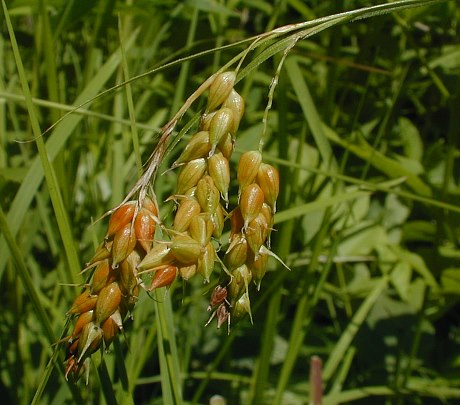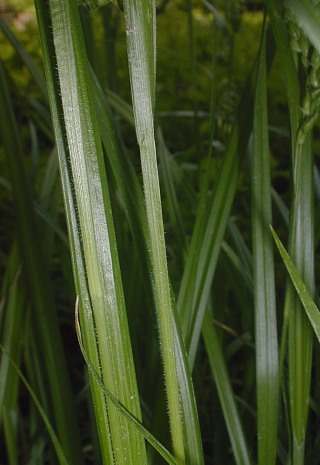Description: This perennial sedge is 1½–3' tall, often forming small loose tufts of fertile and sterile shoots (culms with alternate leaves). The culms are light green, 3-angled, and hairless or slightly hairy. The leaf blades are up to 12" long and 1/3" (8 mm. across); they are light to medium green and channeled along their midveins. The upper surface of each leaf blade is glabrous, while the lower surface is hairless to slightly hairy. The blades are ascending to widely spreading along each culm. The leaf sheaths are light to medium green and usually slightly hairy; the summit of the inner side of each sheath is concave or V-shaped. Plants with completely glabrous foliage occasionally occur, particularly in the western range of Davis' Sedge (Illinois & areas westward).

Each culm
terminates in an inflorescence consisting of 2-5 spikelets and their
leafy bracts. These spikelets are 1–1½" long and cylindrical in shape,
consisting of 12-30 perigynia, florets, and their scales. Initially,
the spikelets are erect and straight, but they often nod sideways at
maturity on pedicels up to 1" long. The uppermost spikelet of each
inflorescence is gynecandrous (pistillate florets above, staminate
florets below), while the remaining spikelets are entirely pistillate.
Shortly after shedding their pollen, the staminate florets wither away
and their slender scales become light brown. The perigynia of the
pistillate florets are 4.0–5.5 mm. long and 2.0 mm. across; they are
ovoid-oblongoid in the shape with very short beaks. The outer surface
of each perigynium is glabrous with 9-12 longitudinal veins that are
evenly spaced. The perigynia are initially light green, but they become
orange-brown at maturity. The pistillate scales are ovate with long
awns; they are as long or longer than the perigynia. Immature
pistillate scales have green midveins, otherwise they are membranous;
at maturity, these scales become light brown and tend to spread outward
from their perigynia. The blooming period occurs from late spring to
early summer; the perigynia and their achenes disarticulate from the
spikelets later during the summer. The achenes are 2.0–2.5 mm. long,
ovoid in shape, and 3-angled; each achene is pointed at the bottom. The
root system is fibrous and short-rhizomatous.

Cultivation:
Davis' Sedge prefers partial sun or dappled sunlight, moist to mesic
conditions, and loamy soil. The fertile culms have a tendency to lean
sideways at maturity.
Range & Habitat:
The native Davis' Sedge is common in most areas of Illinois (see Distribution
Map), except in the SE section of the state, where it is less
common or absent. Habitats include both upland and floodplain deciduous
woodlands (usually where the tree canopy is somewhat open), wooded
slopes along ravines and river valleys, woodland openings and alluvial
meadows, powerline clearances in wooded areas, areas along woodland
paths, and abandoned fields. This sedge can be found in either slightly
degraded or higher quality habitats.
Faunal Associations:
Various insects feed on woodland Carex spp. (sedges). This
includes various aphids, leafhoppers, katydids, larvae of leaf-mining moths, and larvae of a butterfly, Satyrodes appalachia (Appalachian Brown); see the Insect
Table for more information. Among vertebrate animals, the Wood Duck, some upland
gamebirds, and some granivorous songbirds feed on the seeds of these sedges (see Bird Table).
In general, woodland sedges are eaten sparingly by
mammalian herbivores, although White-tailed Deer sometimes browse on
their semi-evergreen rosettes of leaves during the winter, especially
when the species of sedges have wide leaves.
Photographic Location:
The upper photograph was taken at a powerline clearance in Busey Woods
of Urbana, Illinois, while the lower photograph was taken along a path
in a more shaded area of the same woodland.
Comments:
Davis' Sedge is most noticeable when its spikelets become an attractive
orange-brown during the summer, resembling the ripened grains of an
agricultural crop. At maturity, this sedge is rather lanky and floppy.
Davis' Sedge superficially resembles the common Carex grisea
(Wood Gray Sedge), but it lacks the separate staminate spikelets of the
latter species. The spikelets of Davis' Sedge are a little longer than
those of Wood Gray Sedge, and it is more often found in sunnier
habitats. The perigynia of both sedges are oblongoid-ovoid with beaks
that are very short and straight. These perigynia are inflated, rather
than flattened.